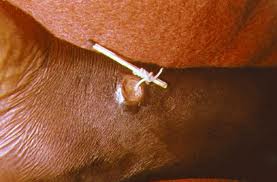Taxonomy
As mentioned previously, this worm is a member of Phylum Nematoda. It belongs in Class Secernentea along side the Rhabditia, which includes the famous genetic model, C. elegans, and the equally famous Ascaris lumbricoides. D. medinensis is in Order Camallanida, whose members have copepods as their secondary hosts. It is in the Family Dracunculidae and the Genus Dracunculus. There are other members of this genus that infect dogs (D. insignis), otters (D. lutrae), opossums (D. fuelliborni), and even reptiles (D. ophidensis). The most medically important one is, you guessed it, D. medinensis. This bad boy has been found infecting humans, dogs, and even horses and cattle.
 |
| D. medinensis Larvae |
 |
| A copepod (Cyclops) that acts as an intermediate host for D. medinensis |
Like all my favorite parasites, this one manipulates the behavior of its host. The guinea worm infects a human host who drinks water that has been contaminated by the worm's intermediate host, a copepod. The copepod dies inside the human's body and releases stage 3 larvae into the stomach. The larvae will move through stomach and intestinal walls to make their way into the abdominal cavity where they mature and mate. The males die after mating, but the females move into the subcutaneous tissues of the body. The female will then form a blister on the skin, usually somewhere on the foot or lower leg. This process takes about a year. The blister will then break open causing severe burning pain. This pain drives the human host to seek water in which to soothe the burning. Once in water, the female is able to sense the change in temperature, and she emerges to release her stage 1 larvae into the liquid environment. The female, which can be as long as 31 inches in length, then suffers the fate of her 1 inch long male companions and dies. The larvae she released into the water are ingested by copepods, in which they molt twice before becoming infectious.
Dracunculiasis
 This is also known as "Guinea worm disease" (appropriately) and is only caused by the female of the species. (As you probably could tell from reading the life cycle.) As stated,a blister usually manifests on the lower extremities, but cases have been reported of dracunculiasis on the buttocks, torso, arms, and even on the genitals. (Ouch!) The blister can cause extreme pain and a burning sensation due to the fact that they elicit allergic reactions within the body. This produces rashes, diarrhea, nausea, edema, and dizziness. These reactions subside when the blister ruptures, but then you have to worry about skin ulcers forming and getting the dead worm out. The worms are removed by slowly winding the worms around a stick to extract them over a period of days or weeks. This is because yanking the worm out causes the worm to break, releasing chemicals that have the potential to cause fatalities. The worm can now be removed surgically, but only if the worm is near the skin's surface. Dead worms in joints can cause arthritis and even paralysis if near the spinal cord.
This is also known as "Guinea worm disease" (appropriately) and is only caused by the female of the species. (As you probably could tell from reading the life cycle.) As stated,a blister usually manifests on the lower extremities, but cases have been reported of dracunculiasis on the buttocks, torso, arms, and even on the genitals. (Ouch!) The blister can cause extreme pain and a burning sensation due to the fact that they elicit allergic reactions within the body. This produces rashes, diarrhea, nausea, edema, and dizziness. These reactions subside when the blister ruptures, but then you have to worry about skin ulcers forming and getting the dead worm out. The worms are removed by slowly winding the worms around a stick to extract them over a period of days or weeks. This is because yanking the worm out causes the worm to break, releasing chemicals that have the potential to cause fatalities. The worm can now be removed surgically, but only if the worm is near the skin's surface. Dead worms in joints can cause arthritis and even paralysis if near the spinal cord.The Moral of the Story
It goes without saying that you shouldn't drink water of questionable origins, but let's say it anyway. Don't drink unfiltered water from questionable sources. Fine mesh nylon is useful for straining larvae infected copepods and several larvacides have been used to treat water sources that may house these little devils. Many organizations have worked tirelessly to eradicate D. medinensis from the worm's home areas of Africa and Asia. Much progress has been made, but there is still work to be done. We can also learn that sometimes it takes patience to rid yourself of parasites...like spending weeks wrapping a worm from your leg around a stick when all you probably want to do is rip that sucker out an call it a day!





No comments:
Post a Comment